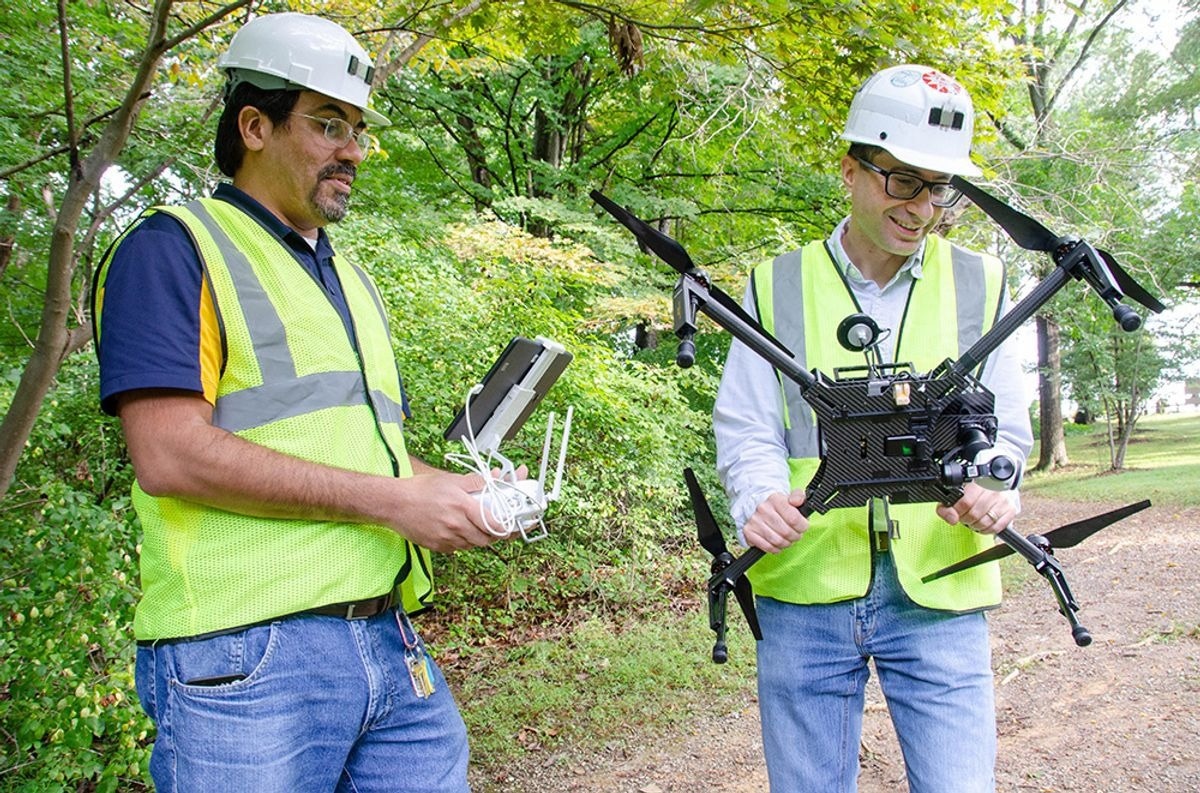Two engineers from West Virginia University (WVU) are involved in creating new robotic technologies for coal waste storage units that will sense and stop probable failures such as leakage of harmful materials into the environment.
 WVU researchers Guilherme Pereira and Ihsan Berk Tulu were recently awarded nearly $500,000 to develop an aerial robot-enabled inspection and monitoring system for abandoned coal waste storage facilities. Image Credit: WVU Photo/Paige Nesbit.
WVU researchers Guilherme Pereira and Ihsan Berk Tulu were recently awarded nearly $500,000 to develop an aerial robot-enabled inspection and monitoring system for abandoned coal waste storage facilities. Image Credit: WVU Photo/Paige Nesbit.
Approximately $500,000 has been funded to Guilherme Pereira, Associate Professor in the Mechanical and Aerospace Engineering Department and adjunct Associate Professor in the Lane Department of Computer Science and Electrical Engineering, and Ihsan Berk Tulu, the Wayne and Kathy Richards Faculty Fellow and Assistant Professor of Mining Engineering.
The funding will go towards bringing about an aerial robot-supported inspection and tracking platform for active and abandoned coal ash and tailings or waste storage units.
The project’s goal is to discover a method to identify failures and leakages at coal waste units before coal ash and tailings are discharged into the environment. Tailings can be described as waste materials kept above-ground behind earthen dams, which remain after coal is mined from the earth. Coal ash can be described as the residue that remains from burning coal at power plants.
Coal ash is one of the largest forms of industrial waste in the US, comprising metals like mercury, lead, arsenic, chromium, cadmium, and selenium, which do not biodegrade and are unsafe for humans.
Failure of these structures has been shown to be catastrophic, causing massive mudslides that have devastated entire communities and created irreversible environmental damage. Industry and federal and state governments spend great effort and time inspecting these structures, finding hazards that might lead to wastewater leakages or failures.
Ihsan Berk Tulu, Wayne and Kathy Richards Faculty Fellow and Assistant Professor, Mining Engineering, West Virginia University
The team will create and set up a smart drone that will independently examine the structural components of coal waste storage units. The drone will be designed to provide visual and thermal images and high-resolution, three-dimensional (3D) maps of the unit, which will allow the detection of deformities, cracks, and other risks in the structures.
The project’s second goal is to develop and fit the drones with software that employs artificial intelligence (AI)-based algorithms to sense potential dangers. The software will gather and use visual and thermal images, as well as 3D point clouds, a technology that employs laser scanners to track where light makes contact with a specific object or surface, to produce extremely precise 3D models of the coal storage units.
This will enable scientists to detect probable risks rapidly and resourcefully without having to be physically available at the inspection zone.
The funding is provided by the US Department of Energy and is managed by the National Energy Technology Laboratory under the University Training and Research for Fossil Energy and Carbon Management Program.
This funding will permit four students at the Benjamin M. Statler College of Engineering and Mineral Resources to take part in this project and gain practical experience associated with autonomous robotic inspection platforms. The study can offer a quicker and long-term cost-effective solution to this growing global problem, an issue that is quite personal for Pereira.
I'm originally from Minas Gerais state in Brazil, where catastrophic accidents with tailing dams happened recently, so the project has a special motivation for me. It is an opportunity to develop a technology that can save lives in the United States and in my country.
Guilherme Pereira, Associate Professor, Department of Mechanical and Aerospace Engineering, West Virginia University
A tailings dam in Bento Rodrigues, Brazil, collapsed in 2015, releasing thousands of pounds of dangerous mud spill that left 19 people dead. The mining waste ultimately flowed over 400 miles from its source to the Atlantic Ocean, polluting water sources along the way.
In 1972, a tailing dam in Logan County, at the heart of West Virginia, failed after a strong rainstorm called the Buffalo Creek Flood. This disastrous dam failure discharged 132 million gallons of wastewater into the nearby community. The incident took the lives of 125 people, injured 1,100 others, and left 4,000 people homeless.
It is a very exciting project for us. We will train the next generation of engineers in the application of robotics technologies for our mining communities. A successful outcome from this project will be another technology tool for both West Virginia’s and the nations’ mining industries to improve the safety of the mines and the health of the nearby communities.
Ihsan Berk Tulu, Wayne and Kathy Richards Faculty Fellow and Assistant Professor, Mining Engineering, West Virginia University
Source: https://wvu.edu